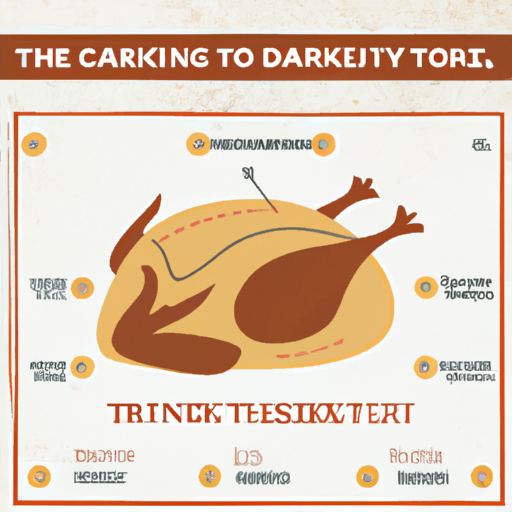If you’re tired of guessing the perfect cooking time and temperature for your Thanksgiving turkey, then the “Ultimate Cooking Chart for Turkey” is here to rescue your feast! Say goodbye to overcooked or undercooked poultry with this handy chart that provides precise instructions on how long to cook your turkey based on its weight. Whether you’re a seasoned chef or a first-time Thanksgiving host, this cooking chart will ensure that your turkey turns out juicy, tender, and cooked to perfection. Say hello to stress-free holiday cooking with the “Ultimate Cooking Chart for Turkey!”
Ultimate Cooking Chart for Turkey
Welcome to the ultimate cooking guide for turkey! Whether you’re a seasoned chef or a novice cook, this comprehensive chart will provide you with all the information you need to prepare a delicious turkey for any occasion. From choosing the right turkey to stuffing and cooking methods, we’ve got you covered. So, grab your apron and let’s get cooking!

Choosing the Right Turkey
When it comes to choosing the right turkey, there are a few factors to consider.
Size of the Turkey
The size of the turkey you choose will depend on the number of guests you’re serving. A general rule of thumb is to estimate about 1 pound per person. This will ensure that everyone has enough to eat and allows for leftovers.
Fresh or Frozen
You have the option of buying a fresh or frozen turkey. Fresh turkeys tend to have a better flavor and texture, but they can be more expensive and harder to find. Frozen turkeys, on the other hand, are more readily available and can be purchased in advance.
Organic or Conventional
Deciding between organic or conventional turkey is a personal choice. Organic turkeys are raised without antibiotics or hormones and are fed organic feed. Conventional turkeys are typically cheaper and more widely available.
Butterball or Other Brands
Butterball is a popular brand known for its quality turkeys. While Butterball turkeys are reliable and delicious, there are many other reputable brands to choose from. Consider your budget and preferences when selecting a brand.
Thawing and Preparing the Turkey
Before you can begin cooking, you’ll need to thaw and prepare your turkey. Here are two methods for thawing your turkey and some tips for preparation.
Thawing in the Fridge
Thawing your turkey in the fridge is the safest method. Simply place your turkey on a tray or in a shallow pan and allow it to thaw in the refrigerator. Plan for 24 hours of thawing time for every 4 to 5 pounds of turkey.
Cold Water Thawing
If you’re short on time, cold water thawing is an option. Fill a clean sink or basin with cold water and submerge the turkey, ensuring it is fully covered. Change the water every 30 minutes to maintain a consistently low temperature. Thawing in cold water takes about 30 minutes per pound.
Preparing the Turkey
Once your turkey is thawed, it’s time to prepare it for cooking. Remove the giblets and neck from the cavity, and rinse the turkey inside and out with cold water. Pat the turkey dry with paper towels and let it come to room temperature before seasoning.
Seasoning and Marinating
Seasoning and marinating your turkey is crucial for adding flavor and enhancing the taste. Here are three popular methods for seasoning and marinating your turkey.
Dry Rubs
Dry rubs consist of a blend of herbs, spices, and salt that you rub onto the turkey’s skin. Choose a combination of your favorite flavors, such as rosemary, thyme, garlic powder, paprika, and black pepper. Massage the dry rub onto the turkey, including under the skin for maximum flavor.
Wet Brines
Wet brines involve soaking the turkey in a mixture of salt, sugar, and various spices in water. This helps to both season the meat and retain moisture. Allow the turkey to soak in the brine for at least 12 hours in the refrigerator before cooking.
Injection Marinades
Injection marinades involve injecting a flavorful liquid directly into the turkey meat using a marinade injector. Popular injection flavors include butter, wine, broth, or a combination of herbs and spices. Inject the marinade evenly throughout the turkey, taking care not to overdo it.

Cooking Methods
Once you’ve prepared your turkey, it’s time to choose a cooking method. Here are five popular methods to consider.
Roasting in the Oven
Roasting in the oven is the traditional method for cooking a turkey, and it yields delicious results. Preheat your oven to the recommended temperature, typically around 325°F. Place the turkey on a roasting rack in a roasting pan and cook until the internal temperature reaches 165°F.
Grilling
Grilling a turkey can add a unique and smoky flavor to the meat. Preheat your grill and prepare for either direct or indirect heat cooking. Place the turkey on the grill and cook until the internal temperature reaches 165°F, basting occasionally to keep it moist.
Deep Frying
Deep frying a turkey produces a juicy and flavorful result with a crispy skin. Use a deep fryer specifically designed for turkeys and follow the manufacturer’s instructions for temperature and cooking time. Ensure that the turkey is fully submerged in oil and monitor the cooking process carefully for safety.
Smoking
Smoking a turkey imparts a rich and smoky flavor. Use a smoker or a charcoal grill with indirect heat. Soak wood chips in water for at least 30 minutes, then add them to the smoker or grill. Cook the turkey until the internal temperature reaches 165°F, basting as desired.
Spatchcocking
Spatchcocking involves removing the backbone of the turkey and flattening it before cooking. This method reduces cooking time and ensures even cooking throughout. Preheat your oven or grill, place the spatchcocked turkey on a baking sheet or grill grates, and cook until the internal temperature reaches 165°F.
Roasting in the Oven
Roasting a turkey in the oven is a classic and reliable method. Follow these steps for a perfectly roasted turkey.
Preheating the Oven
Preheat your oven to the recommended temperature, typically around 325°F. Ensure that your oven is fully heated before placing the turkey inside.
Cooking Temperature and Time
Cooking times will vary depending on the size of your turkey. As a general guideline, plan for about 15 minutes per pound. Use a meat thermometer to check the internal temperature, which should reach 165°F at the thickest part of the thigh.
Basting the Turkey
Basting the turkey throughout the cooking process helps to keep it moist and adds flavor. Use a baster or a spoon to drizzle the turkey with pan drippings or melted butter every 30 minutes.
Using a Roasting Pan
Place the turkey on a rack in a roasting pan to elevate it and allow for even heat distribution. This also helps to prevent the bottom of the turkey from getting soggy.
Resting the Turkey
After removing the turkey from the oven, let it rest for about 20 minutes before carving. This allows the juices to redistribute and ensures a juicy and flavorful bird.
Grilling
Grilling a turkey can be a fun and tasty alternative to the traditional oven-roasted method. Here’s how to grill your turkey to perfection.
Preparations on the Grill
Preheat your grill to medium heat, around 350°F. Clean and oil the grill grates to prevent sticking. Place the turkey on the grill, breast-side up, and close the lid. Keep a spray bottle of water nearby to control any flare-ups.
Direct or Indirect Heat
Grill your turkey using either direct or indirect heat, depending on the size and thickness of the bird. Direct heat is suitable for smaller turkeys, while indirect heat is best for larger ones. Monitor the internal temperature using a meat thermometer.
Cooking Temperature and Time
Grilling times will vary, but approximately 12-15 minutes per pound is a good guideline. Use a meat thermometer to ensure the internal temperature reaches 165°F.
Basting the Turkey
While grilling, baste the turkey with a flavorful marinade or melted butter every 30 minutes to keep it moist and add extra flavor.
Resting the Turkey
Once the turkey reaches the appropriate internal temperature, remove it from the grill and let it rest for about 20 minutes before carving. This resting period allows the juices to redistribute, resulting in a tender and juicy turkey.
Deep Frying
Deep frying a turkey can yield a succulent and crispy result. However, caution must be taken due to safety concerns. Follow these steps to deep fry your turkey safely.
Choosing a Deep Fryer
Use a deep fryer specifically designed for turkey frying. Ensure that it is on a stable and non-flammable surface, such as concrete, away from any structures or overhanging trees.
Prepping the Fryer
Fill the fryer with oil, leaving enough room for the turkey. Use a cooking thermometer to monitor the oil temperature, which should be around 350°F. Lower the turkey slowly into the hot oil, using the handles provided with the fryer.
Cooking Temperature and Time
To ensure the turkey is fully cooked, the internal temperature should reach 165°F. Use a meat thermometer to check the temperature, typically needing 3-4 minutes per pound of frying time.
Safety Precautions
Never operate a deep fryer indoors or leave it unattended. Keep a fire extinguisher nearby and dress appropriately, including protective gloves and eyewear. Follow the manufacturer’s instructions and safety guidelines carefully.
Resting the Turkey
Once the turkey is cooked, carefully remove it from the fryer and let it rest for about 20 minutes before carving. This resting period allows the juices to distribute and results in a moist and flavorful turkey.
Smoking
Smoking a turkey adds a unique and smoky flavor to the meat. Here’s how to smoke your turkey to perfection.
Choosing the Right Wood Chips
Selecting the right wood chips is essential for achieving the desired smoky flavor. Popular choices include apple, hickory, mesquite, and cherry wood chips. Soak the wood chips in water for at least 30 minutes before using them in the smoker.
Preparing the Smoker
Preheat your smoker to a temperature between 225°F to 250°F. Add the soaked wood chips to the smoker’s designated area, ensuring a steady flow of smoke. Place the turkey on a rack in the smoker, breast-side up.
Cooking Temperature and Time
Smoking times will vary depending on the size and temperature of your smoker. As a general guideline, allow approximately 30 minutes per pound. Use a meat thermometer to check for an internal temperature of 165°F.
Controlled Smoking
While smoking, you may choose to baste the turkey with a flavorful marinade or mop sauce to enhance the taste and moisture. Maintain a steady temperature in the smoker and replenish the wood chips as needed.
Resting the Turkey
Once the turkey has reached the desired internal temperature, carefully remove it from the smoker and let it rest for about 20 minutes before carving. This resting period allows the juices to redistribute, resulting in a tender and flavorful turkey.
Stuffing the Turkey
Stuffing the turkey adds extra flavor and creates a delicious side dish. Here are some tips for stuffing your turkey safely and to perfection.
To Stuff or Not to Stuff
Decide whether you want to stuff your turkey or cook the stuffing separately. Stuffing the turkey can enhance the flavor, but it requires additional cooking time and can present food safety risks if not done correctly.
Preparing the Stuffing
If you decide to stuff your turkey, prepare the stuffing just before you’re ready to cook. Make sure all ingredients are fully cooked before stuffing, and never stuff a turkey in advance as this can promote bacterial growth.
Cooking Temperature and Time
Ensure that the stuffing reaches an internal temperature of 165°F to be safe for consumption. Use a meat thermometer to check the temperature, as it may require additional cooking time compared to the turkey itself.
Ensuring Safety
To prevent bacterial growth, stuff the turkey just before cooking and remove any leftover stuffing promptly after cooking. Ensure the stuffing does not touch the sides of the turkey cavity and cook the turkey until the internal temperature reaches 165°F.
With this ultimate cooking chart for turkey, you now have all the information you need to prepare a mouthwatering turkey for any occasion. Whether you choose to roast in the oven, grill, deep fry, smoke, or even spatchcock your turkey, follow the recommended tips and techniques for a flavorful and perfectly cooked bird. So, gather your ingredients, put on your chef’s hat, and get ready to impress your family and friends with your turkey-cooking skills!
